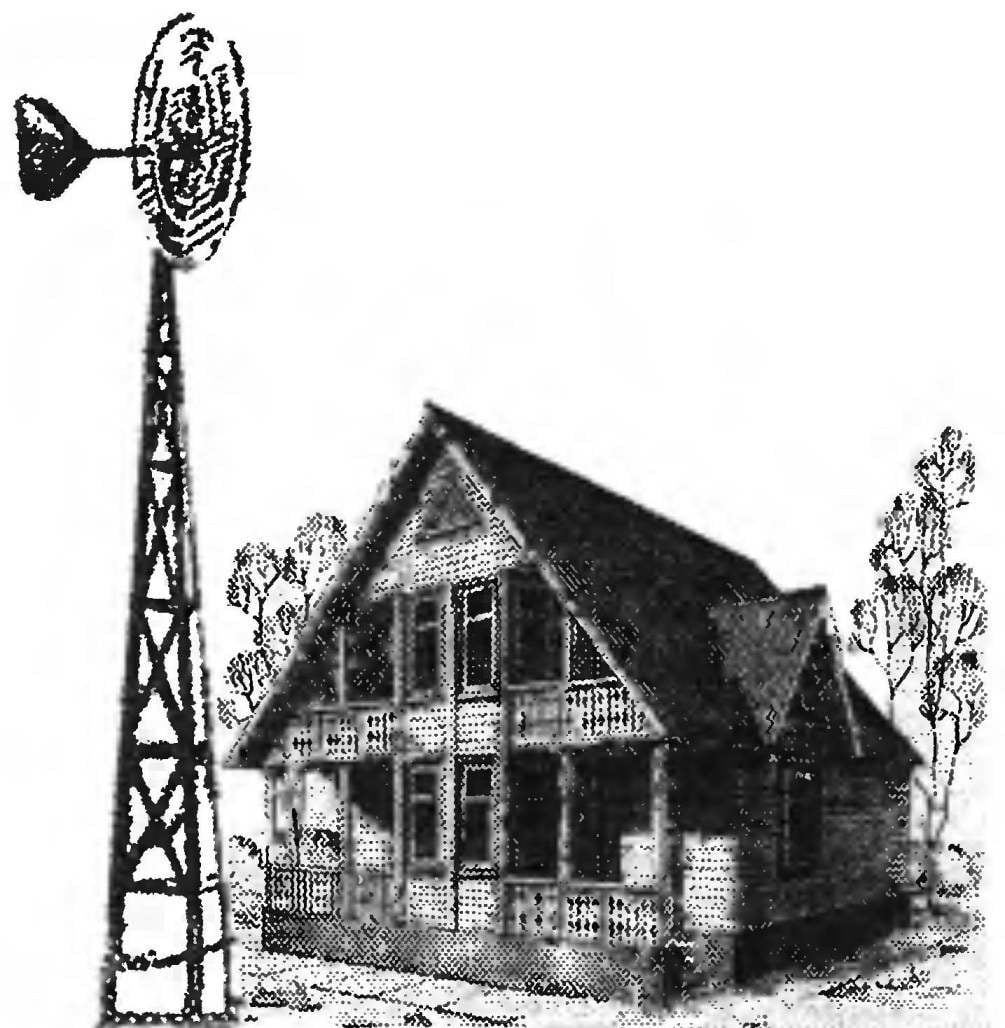Note that the installation height of the propeller depends on the presence of obstacles (trees, buildings, and other structures) located in the immediate vicinity. Ideally, the blade of the propeller must be above nearby obstructions not less than two meters. You must consider that the impact of obstacles on the air flow extends to a distance equal to fifteen times its height.
Wind power plant with horizontal axis of rotation, despite the relatively high efficiency, has its drawbacks. In particular, the transfer of large current through the collector causes significant losses of energy and can lead to trouble as due to contact failure during their oxidation, and reduce the elasticity of the plates, brush gear. And again, the wind wheel of this type has the qualities of a gyro — gyroscope tending to maintain the space orientation of the axis of rotation. Therefore, the changes in wind direction occurs a significant load on the bearings, reducing their service life.
“Rotor”
In many cases, more viable rotary wind farm, which wind wheel has a vertical axis of rotation and can operate at any wind direction.
There are several types of rotary wind turbines. One of the simplest and most effective is WindRotor representing cut on a diametrical plane of a hollow cylinder with an offset relative to each other parts. This rotor although Tehachapi propeller, but has more torque and able to work under negligible wind speeds. The main thing is its ability to rotate in any wind direction and as a consequence — the absence of the rotary device and the collector.
The advantages of VES with vingretto-ROM is the simplicity of its design.
A rotary turbine mounted on a pole or mast. How this is done, readers already know from the description of the WEC of the type “Disk”. The base is welded from steel angles section 4x40x40 mm. In the upper part is welded to stepped shaft on which is mounted the brake drum from the wheel of the motorcycle “Ural” or “Ij”.
The rotor is made of plywood. You will need three discs with a diameter of 1000 mm and a thickness of 10 mm for aerodynamic washers, baffles and four plate size 500 1050 mm thickness 4…5 mm for rotor blades. The joining of all these elements is performed using a dural corners section 30x30x2 mm, bent as shown on the drawings, and bolts M5 nuts and washers. The rotor is reinforced by ties from steel rods with a diameter of 6 mm with thread on the ends. The lower washer reinforced with wooden bruski section 40×40 mm.
The theoretical drawing of a two-bladed propeller
Wind Power Rotor:
1—generator of type G-221; 2,4,6,17—aerodynamic washer rotary propeller; 3,5,18—blade rotor; 7—chain transmission multiplier; 8—hub of the propeller (brake drum motorcycle); 9,16—blade aerodynamic braking devices; 10—the axis of rotation of the rotary propeller; 11—bearing; 12—lugs fastening stretch marks; 13—an arm of fastening of the generator; 14—strengthening of the lower aerodynamic washers (wooden block 40×40 mm); 15—bracket (area 30x30x2 mm, made of anodized aluminum)
After pre-Assembly the rotor is disassembled, plywood elements two to three times impregnated with hot linseed oil, after which it going finally and colored alkyd enamel.
For a bearing Assembly (brake drum from motorcycle) the rotor is mounted with distance bushings and bolts M8 nuts and washers. Between the hub and rotor is a homemade sprocket chain multiplier and the generator shaft — counter shaft (small sprocket from the motor D8 or V-50). The drive sprocket is cut out of duralumin sheet thickness of 4 mm by a known technology, when its pitch circle, first mark the centres of the holes forming the cavities in the teeth and then using a drill, hacksaw and files are formed the teeth themselves. The gear ratio multiplier I = 5…6.
Automotive generator installed on the bracket, constituting together with the base of WindRotor a single welded node. Alternator mounting bracket — standard like on the car: using hinge and screw retainer-tensioner.
Rotary wind turbine is equipped with almost the same brake device, and WEC type “Disk”. Drive it also aerodynamic: on the axis of the brake Cam fixed steel sleeve with four welded tubular rods. At the end of each semi-cylindrical located a plywood blade. The spring tightens the brake pads replaced by a different, less rigidity. Actuating this device shall at wind speeds above 10 m/s.
Electronic circuit rotary WPP is no different from that used on the turbine Disk.
 The wind has always been a symbol of impermanence, and attempts to transform its energy into electrical energy has led often to results that are not very encouraging. Indeed, everything you expect from the source of electrical energy stability: clicked the switch and turned on the light. And the wind, alas, changeable. However, to make it a reliable source of electricity possible, to use already well developed scheme with intermediate energy storage battery.
The wind has always been a symbol of impermanence, and attempts to transform its energy into electrical energy has led often to results that are not very encouraging. Indeed, everything you expect from the source of electrical energy stability: clicked the switch and turned on the light. And the wind, alas, changeable. However, to make it a reliable source of electricity possible, to use already well developed scheme with intermediate energy storage battery.
